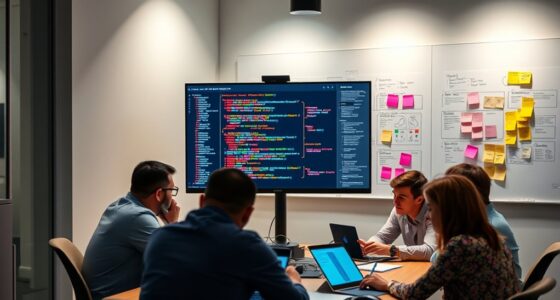To integrate AI agents into your software development lifecycle, you need to focus on responsible training, ensuring your datasets are accurate and unbiased. Incorporate transparency and documentation to build trust and enable explainability. Continuously monitor and update the AI models after deployment to catch biases and maintain performance. Following best practices in ethical AI use can boost quality and confidence in your projects. Keep exploring these strategies to access their full potential.
Key Takeaways
- Incorporate AI tools early in planning to automate requirements analysis and identify potential risks.
- Use transparent training datasets and documentation to ensure ethical AI behavior throughout development phases.
- Monitor AI performance continuously post-deployment to detect biases, model drift, and maintain reliability.
- Implement regular audits and feedback loops to improve AI suggestions and ensure alignment with project goals.
- Follow best practices for responsible AI, emphasizing transparency, bias mitigation, and ongoing oversight during integration.

As artificial intelligence continues to advance, integrating AI agents into software development has become a game-changer for teams seeking increased efficiency and innovation. When you incorporate AI into your development process, one of the first steps is AI model training. This involves feeding large, relevant datasets into the AI system so it can learn patterns, make predictions, and automate tasks effectively. You need to guarantee your training data is extensive, accurate, and free from biases, as these factors directly influence the AI’s performance and reliability. Proper training helps the AI understand the nuances of your project requirements, leading to smarter code suggestions, bug detection, and decision-making support. However, as you train your AI models, it’s essential to contemplate ethical considerations. Biases in training data can inadvertently cause your AI to produce unfair or harmful outputs. Consequently, you must scrutinize your datasets and implement measures to mitigate bias, guaranteeing that your AI operates ethically and responsibly. Transparency in how your AI models are trained and used also plays an indispensable role in building trust among your team and end-users. You should document your training processes, data sources, and decision criteria so that your AI’s actions remain explainable and accountable. This transparency helps prevent unintended consequences and aligns your AI integration with ethical standards and legal regulations. Additionally, regularly auditing your AI models after deployment is necessary to catch any drift or bias that may arise over time. When you focus on ethical considerations during AI model training, you not only protect your users but also strengthen your team’s credibility and reputation. It’s a proactive way to address potential issues before they escalate, ensuring that your AI-driven solutions are fair, unbiased, and trustworthy. As you progress in integrating AI agents into your development lifecycle, remember that continuous monitoring and updates are key. The landscape of AI ethics is evolving, and staying informed about emerging standards and best practices will help you maintain responsible AI use. Continuous monitoring and updates are especially crucial given the vulnerabilities and biases that can emerge over time, as identified in recent research on AI trustworthiness. Incorporating ethical training practices ensures that your AI remains aligned with societal values and legal standards, fostering greater user confidence and compliance.
Frequently Asked Questions
How Do AI Agents Handle Complex or Ambiguous Project Requirements?
When faced with complex or ambiguous project requirements, AI agents use contextual interpretation to understand subtle nuances and underlying meanings. They analyze available data, ask clarifying questions, and leverage prior knowledge to resolve ambiguity. This process helps guarantee your project stays on track by accurately capturing requirements, reducing misunderstandings, and adapting to evolving needs through continuous learning and feedback, ultimately delivering solutions that align well with your goals.
What Are the Best Practices for Training AI Agents in Software Teams?
Think of training AI agents as nurturing a garden—you need the right strategies. Focus on clear training strategies that include continuous learning, feedback loops, and real-world data. Encourage team collaboration by involving developers, testers, and stakeholders in the process. This teamwork helps refine AI performance and aligns it with project goals. Regular updates and monitoring make sure your AI stays sharp, making your development process smoother and more efficient.
How Do AI Agents Impact Traditional Developer Roles and Responsibilities?
AI agents transform your traditional developer roles by enabling more collaborative workflows. You’ll find your responsibilities shift towards overseeing AI outputs, ensuring quality, and integrating new tools. Skill adaptation becomes essential as you learn to work alongside AI, leveraging its strengths while maintaining control. This collaborative approach enhances productivity and innovation, but it also requires you to stay flexible and continuously develop your skills to keep up with evolving AI capabilities.
What Are the Common Security Concerns When Integrating AI Agents?
When you integrate AI agents, security concerns like data privacy become critical, as these tools often handle sensitive information. You need to guarantee proper threat mitigation measures are in place to prevent unauthorized access or data breaches. Additionally, it’s essential to regularly update AI systems and monitor their activity to identify vulnerabilities early, safeguarding both your data and systems from potential threats.
How Is AI Agent Performance Monitored and Improved Over Time?
Monitoring AI agent performance is like tending a garden—regular checks help it flourish. You track performance metrics such as accuracy, response time, and user feedback to gauge effectiveness. To guarantee continuous improvement, you analyze this data, identify areas for enhancement, and update the models accordingly. This ongoing process keeps your AI agents sharp, adaptive, and reliable over time, ensuring they meet evolving needs and deliver ideal results.
Conclusion
By integrating AI agents into your software development process, you’ll transform your workflow into an unstoppable, lightning-fast innovation machine. Imagine code reviews done in seconds, bugs squashed before they even appear, and features deployed at the speed of thought—your competitors won’t stand a chance! Embrace AI now, and watch your projects soar to heights you once thought impossible. This isn’t just evolution; it’s a revolution that’ll make your development process legendary.









